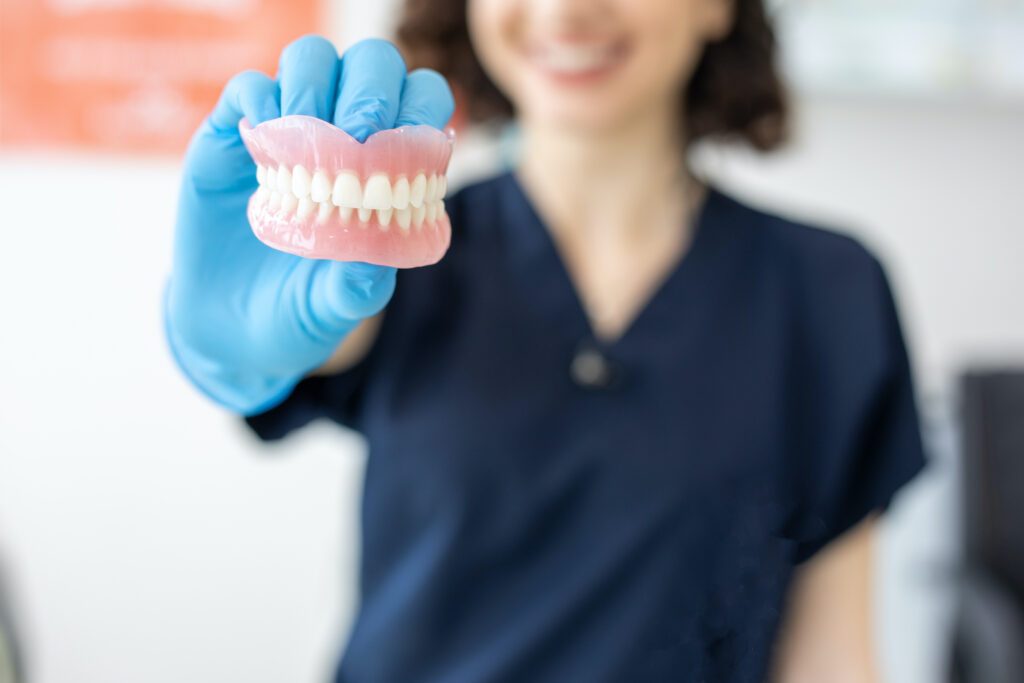
Dentures and veneers are common solutions for different dental issues. Veneers are designed to conceal aesthetic imperfections while dentures replace missing teeth. This article will explain the difference in more detail to help you decide which dental procedure makes the most sense for you.
Table of contents
- Veneers vs. Dentures: Which Is Right for You?
- What Are Veneers?
- What Are Dentures?
- 3 Alternatives to Dentures and Veneers for Missing Teeth
Veneers vs. Dentures: Which Is Right for You?
Because veneers can only be bonded to existing teeth, you can’t get them if you don’t have teeth. Dental veneers are designed to improve the cosmetic appearance when your teeth have imperfections. Dentures, on the other hand, are best for people with extensive missing teeth. Complete dentures require you to have all your teeth removed, while partial dentures can attach to some remaining teeth. When done correctly, both veneers and dentures look natural and can help you get a more beautiful smile.
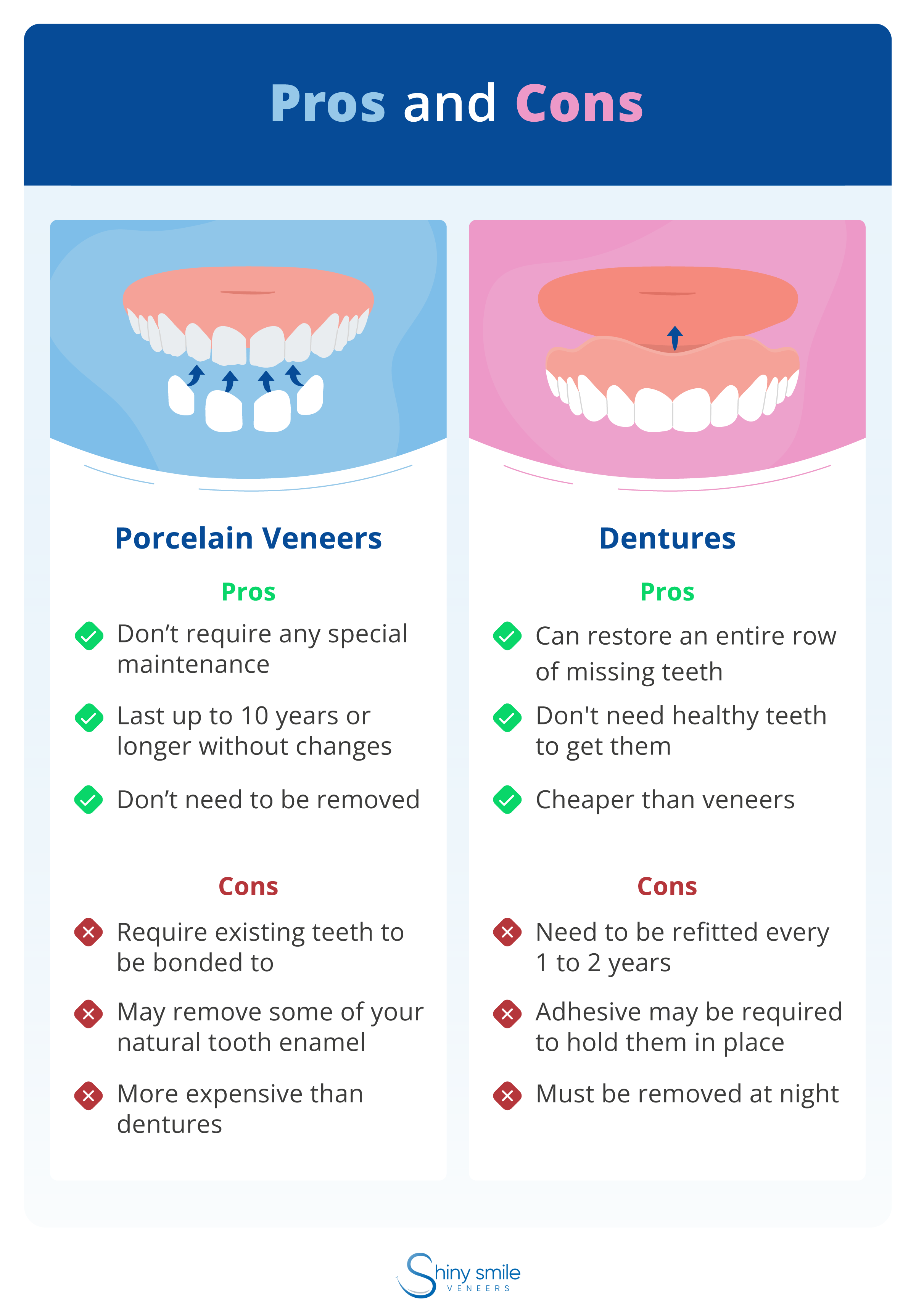
What Are Veneers?
Veneers are thin shells made of porcelain or resin that fit over your teeth to conceal aesthetic imperfections like chips, cracks, and gaps. Most types of veneers are permanent and require you to have existing teeth. While veneers have both pros and cons, they’re generally not suitable for people with serious oral health issues, such as gum disease or tooth decay, or extensive missing teeth. Removable snap-on veneers are a great solution if you have a missing tooth — or several missing teeth — because they attach to teeth on either side..
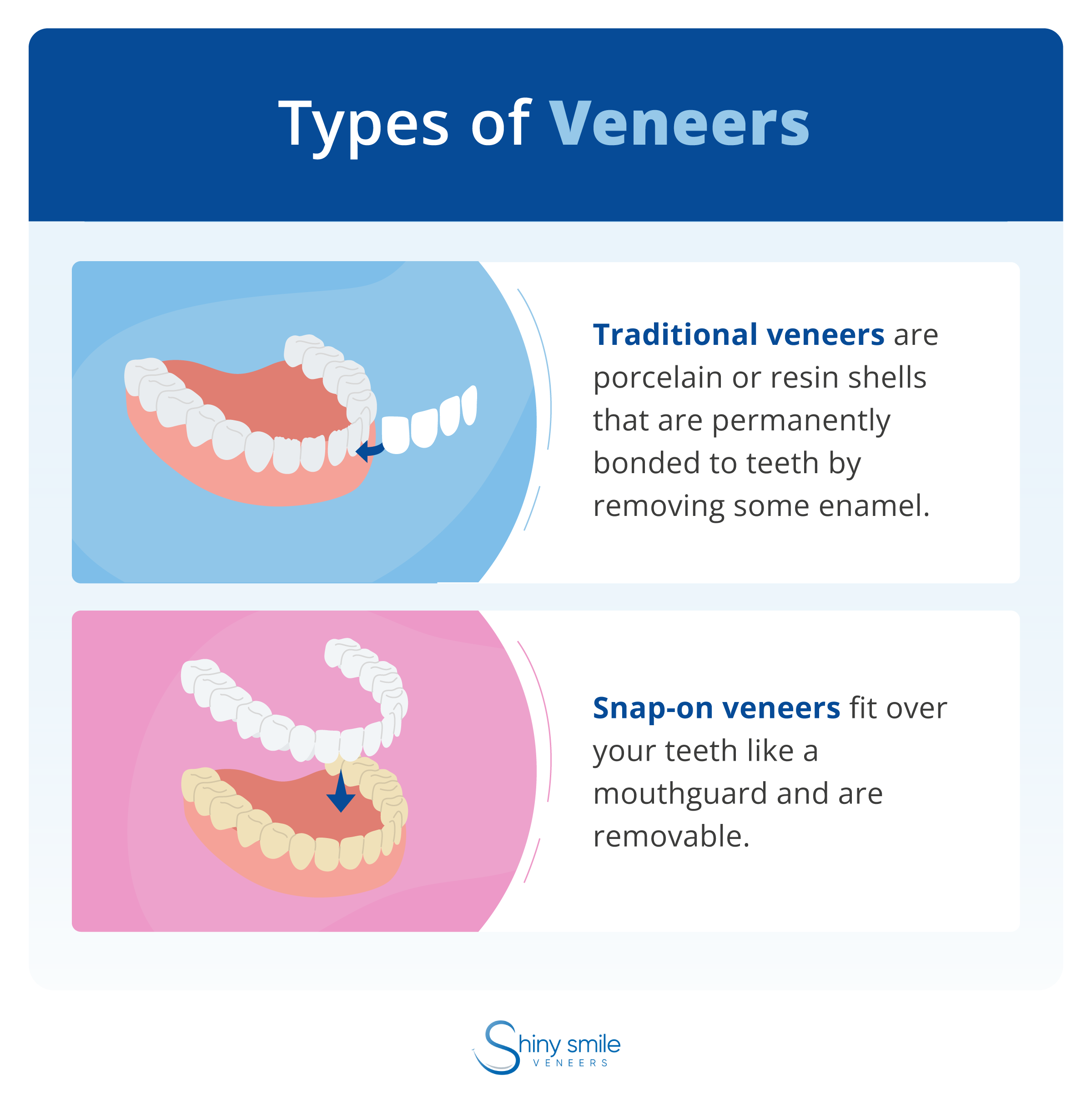
Types
Veneers come in both permanent and temporary options and can be made of a variety of materials. Some require a visit to a dentist while others can be fitted at home.
- Porcelain veneers: These permanent veneers are made of translucent porcelain, which is durable and natural looking, but the procedure requires the removal of natural tooth enamel.
- Composite veneers: Made of composite resin, these veneers require less enamel to be removed but are also less durable than porcelain veneers.
- Snap-on veneers: These temporary veneers fit over your natural teeth like a mouthguard and don’t damage your teeth. You can fit them yourself at home and remove them whenever you would like.
Procedure
Getting veneers is a cosmetic dental procedure that usually requires two to three visits to a dentist over approximately six weeks. The treatment typically involves the following steps:
- A dentist assesses your eligibility for veneers by examining your teeth and discusses your preference for the type of veneer.
- The dentist prepares your teeth for the dental treatment by removing some of your natural enamel.
- If you choose porcelain veneers, the dentist will take impressions of your teeth and send them to a dental lab to make the veneers. They’ll be bonded to your teeth at a follow-up appointment. If you choose composite material, the veneers will be bonded to your teeth after the enamel is removed.
Lifespan
Porcelain veneers typically last up to 10 years or longer, with some studies showing they may last up to 20 years. Composite veneers typically last up to 5 years or longer.
Care
Damaged porcelain veneers can only be replaced, not repaired. So make sure to care for your veneers by practicing good dental health habits, including the following:
- Maintain good oral hygiene by flossing and brushing.
- Be careful chewing hard food.
- Avoid chewing on objects.
- Brush or rinse your mouth after consuming foods or drinks that could cause staining (like red wine).
Cost
The cost of veneers depends on the material and type you choose. The most durable but expensive material, porcelain veneers cost approximately $925 to $2,500 per tooth. Composite veneers typically cost less, around $250 to $1,500 per tooth. Shiny Smile snap-on veneers cost $570 per set.
What Are Dentures?
Dentures, also known as false teeth, are a removable dental appliance that replaces missing teeth (even if you’ve lost them all). If you’ve experienced tooth loss, dentures make it easier to speak and eat. They can improve the appearance of your smile and your entire face. Because your jawbone can’t maintain the same level of health, it can’t support your facial structure, so your facial muscles tend to sag when you lose teeth.
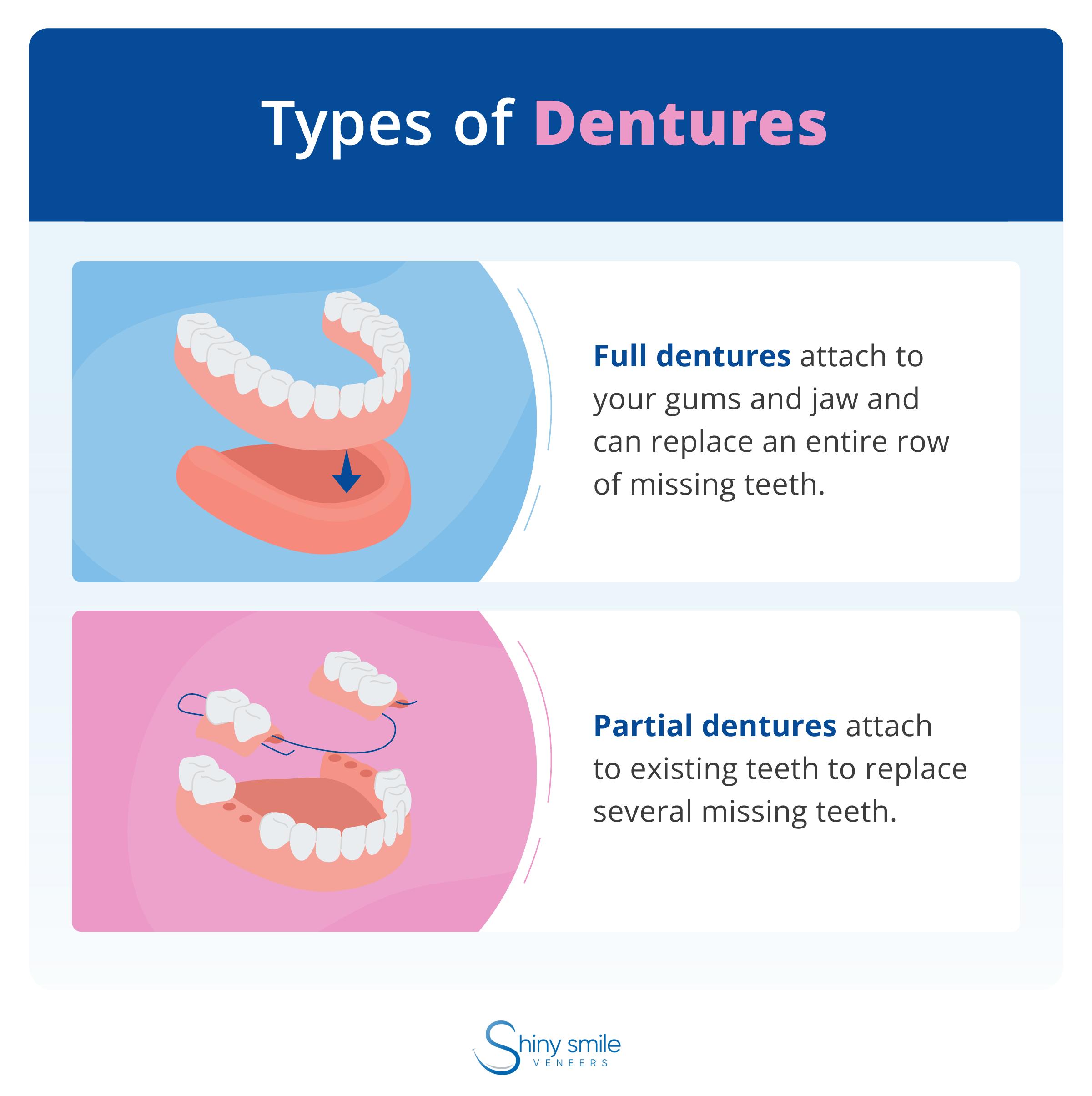
Types
Complete dentures require you to have no teeth or all your teeth removed, while partial dentures can attach to your existing tooth structure or jawbone.
- Full: Usually what people think of when they hear “dentures,” full dentures replace an entire arch of missing teeth and are used if you have all your teeth removed. Although they are made to be held in place by the muscles of your mouth, these removable dentures may also require the use of an adhesive and need to be taken out at night. Types of complete dentures include the following:
- Conventional: Conventional dentures are used once your mouth has healed from tooth removal, which may take several months.
- Immediate: Immediate dentures can be used the same day that any remaining teeth are removed without needing to wait until your mouth has healed. The dentures may need to be remade once your jaw has healed.
- Partial: If you’re not missing all your real teeth, a partial denture can attach to existing teeth as well as receive support from your jaw/gums.
- Implant-retained: This type attaches to dental implants (which are placed in your jaw to replace tooth roots). Often called “snap-in dentures,” these dentures are still removable but are more stable than attaching with an adhesive.
- Implant-supported: These permanent dentures attach to implants and can only be removed by a dentist.
Procedure
How long it takes to get dentures depends on the type of denture and your individual dental situation. The development process typically requires a few weeks and several appointments to complete, plus an additional few weeks to get used to the dentures and make any adjustments. If you’re getting complete/full dentures, it may take 8 to 12 weeks for the mouth to heal after teeth have been removed before the dentures can be fitted.
The denture procedure usually involves the following steps:
- A dentist determines if you’re eligible for dentures by examining your teeth and taking x-rays.
- To make the dentures, the dentist will take impressions of your jaw to make a model/replica of your mouth.
- The model will be used to create the final dentures from acrylic, nylon, or resin.
- The dentist fits the dentures. It may take several visits to achieve the right fit because the soft tissues in your mouth take time to adjust. The appliance may feel awkward until then.
Lifespan
With proper care and maintenance, dentures can last 7 to 10 years. However, the American Dental Association (ADA) recommends that dentures be re-evaluated after five years. Additionally, you should get a denture reline every 1 to 2 years. This means the dentist will add material to the dentures to achieve a better fit.
Care
To keep them in place, dentures sometimes require the use of a dental adhesive. You also should add a few steps to your dental care routine to keep your dentures and your oral health in good condition, including the following:
- Remove them at the end of the day and soak overnight in a denture solution.
- Clean them using a denture brush and a denture cleaning paste.
- Brush any remaining teeth plus around the inside of your mouth twice a day.
Cost
Full dentures may cost up to $3,500 without insurance, while partial dentures may cost $500 to $1,500 without insurance. However, many dental insurance policies will cover some or all of the cost of dentures.
3 Alternatives to Dentures and Veneers for Missing Teeth
Dentures and dental veneers aren’t your only treatment options for missing teeth. The following alternatives can also help fix or conceal dental flaws.
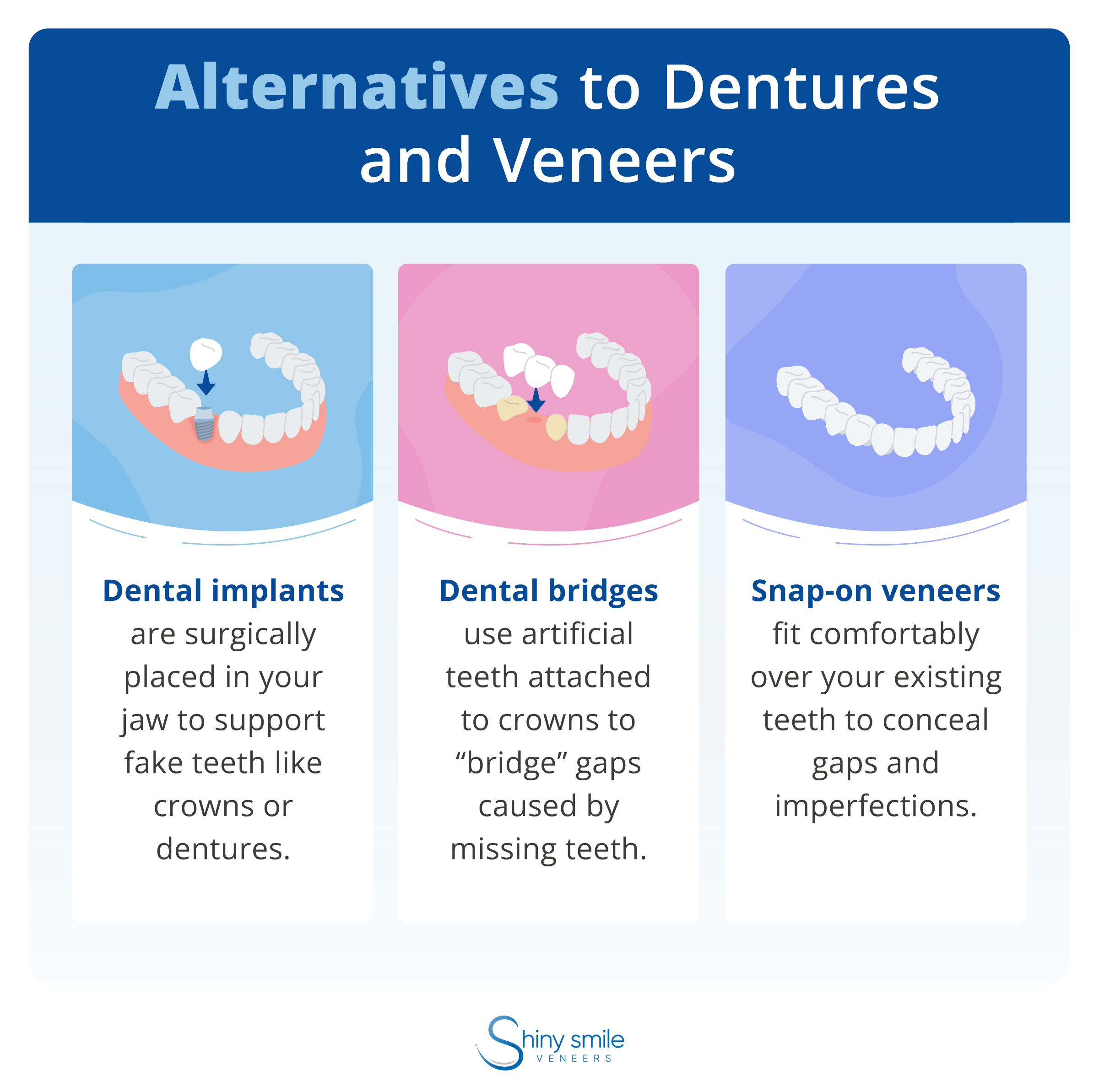
Dental Implants
Dental implants are artificial tooth roots placed into your jaw and then combined with prosthetic teeth (or fake teeth) like crowns and bridges. Getting implants requires surgery so there may be some discomfort. The gums typically take several weeks to heal so you may experience some pain. There are some risks associated with dental implants, including injury to the surrounding teeth and gums during surgery. Implants can also be used to provide support for some types of dentures.
Dental Bridges
A dental bridge can fill a gap caused by missing teeth. It uses an artificial tooth attached to crowns on either side of the gap. However, to get a bridge you need healthy teeth on either side of the missing ones. Dental bridges don’t require surgery but do require a visit to a dentist, and you may experience some discomfort as the replacement teeth are fitted.
Snap-On Veneers
Removable snap-on veneers fit over your existing teeth like a mouth guard. While you can use snap-on veneers for missing teeth, you still need some teeth for them to attach to. Removable veneers don’t require you to go to a dentist and experience surgery or risk potential discomfort or complications.
Get Your Smile Back
Both dentures and veneers can improve the appearance of your teeth, but the right choice for you depends on your particular dental needs. Full dentures are a good option if you have lots of missing teeth, whereas traditional veneers require you to have existing teeth. If you only have several missing teeth, partial dentures or snap-on veneers may work well for you. Shiny Smile snap-on veneers are the affordable, removable way to get your smile back.
